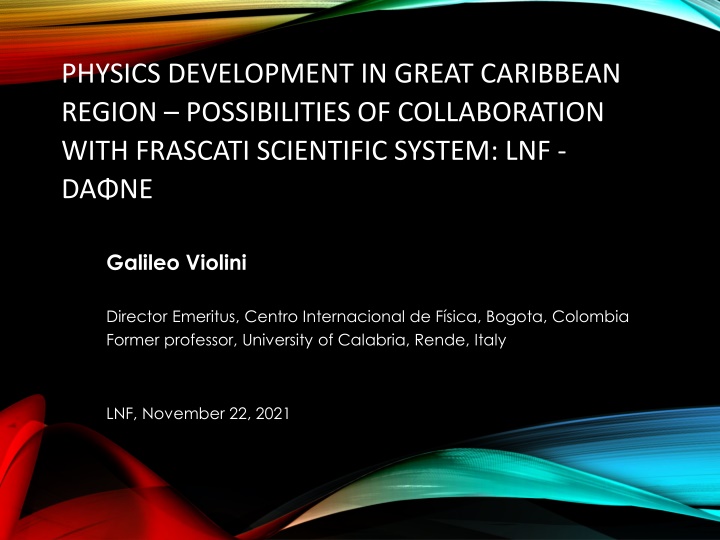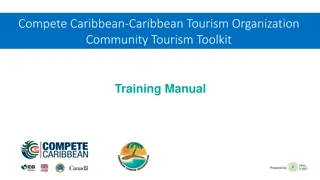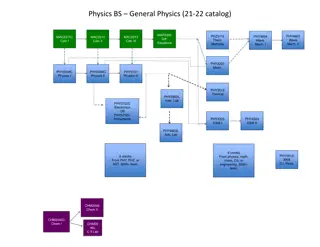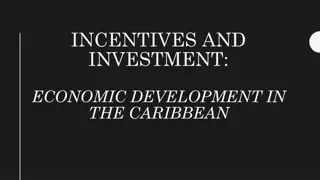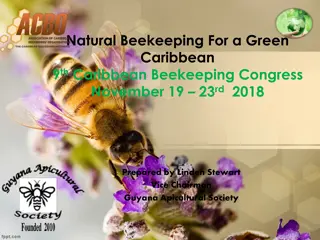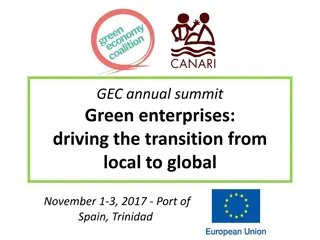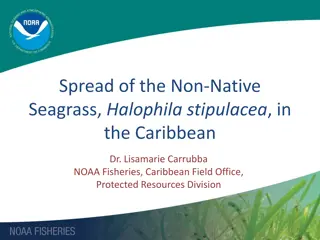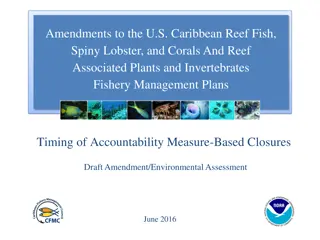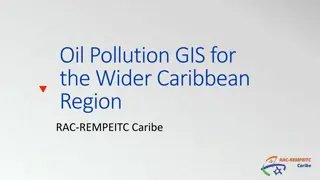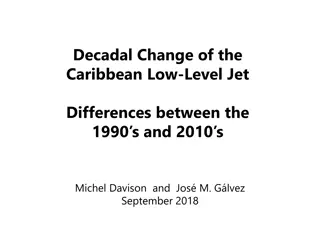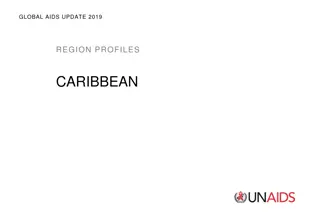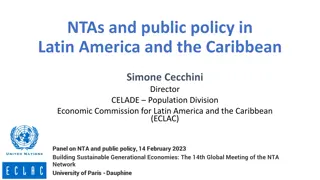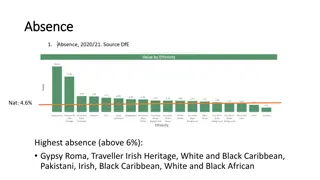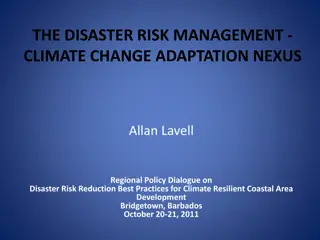PHYSICS DEVELOPMENT IN GREAT CARIBBEAN REGION
The potential collaborations between the Great Caribbean Region and the Frascati Scientific System, focusing on physics development, needs in research, infrastructure, training, and financing. Delve into the history of science in Latin America and the evolution of universities in the region, highlighting key figures advocating for scientific progress. Reflect on the current development model with limited focus on science and exceptions in political leadership. Dive into a famous citation urging active participation in the advancement of natural sciences.
Download Presentation

Please find below an Image/Link to download the presentation.
The content on the website is provided AS IS for your information and personal use only. It may not be sold, licensed, or shared on other websites without obtaining consent from the author.If you encounter any issues during the download, it is possible that the publisher has removed the file from their server.
You are allowed to download the files provided on this website for personal or commercial use, subject to the condition that they are used lawfully. All files are the property of their respective owners.
The content on the website is provided AS IS for your information and personal use only. It may not be sold, licensed, or shared on other websites without obtaining consent from the author.
E N D
Presentation Transcript
PHYSICS DEVELOPMENT IN GREAT CARIBBEAN REGION POSSIBILITIES OF COLLABORATION WITH FRASCATI SCIENTIFIC SYSTEM: LNF - DA NE Galileo Violini Director Emeritus, Centro Internacional de F sica, Bogota, Colombia Former professor, University of Calabria, Rende, Italy LNF, November 22, 2021
TOPICS Science in Latin America Physics (mainly, Argentina, Brazil, Mexico) Physics in Andean Region and Central America Salam, ICTP and Latin America Present situation Needs (Research, Infrastructure, Training, Financing) A synchrotron? Possibilities of cooperation with LNF at DA NE Not only Hispanic countries Not only LNF in Frascati A personal appreciation of countries potential perspectives Frascati and Latin America Pablo Neruda (1951)
LATIN AMERICAN UNIVERSITIES Colonial Period: Habsburg: 20 - Essentially religious universities, Science practically absent 1538 UASD (first American University, Paul III s Papal Bull), 1551 UNAM and San Marcos (Carlos I (V) Felipe II s Royal Cedula) 1676 USAC (first Center American University, but already 1562 Colegio Universitario Santo Tomas Borbons: 8 - La Habana, Los Andes (M rida), Guadalajara, Medell n Brazil: 1792 Escuela de Ingenieria Rio de Janeiro Republican Period [Science almost absent, but interesting statemen statements Buenos Aires (1821), Cartagena (1827), Central Universities: Quito, Bogota, Caracas (Santander,1826), 1854 Escuela Nacional de Agricultura y Veterinaria (today Universidad Aut noma Chapingo),1872 Escuela Polit cnica Nacional (Quito)
LA DEVELOPMENT MODEL - Explotation of Natural Resources - Agriculture - Tourism - Trade Internal economies Little interests of the politicall leaders for the possible role of Science Some exceptions - XIX Century: Bol var, Rivadavia, Castro Madriz, Garc a Moreno Sarmiento, - Last two decades: Correa, Fern ndez, Cerezo
A FAMOUS CITATION Domingo Argentina: "Well, I say we should give up the rank of nation, or the title of civilized country, if we do not take our part in the progress and movement of natural sciences . (Inauguration Observatory, 1878) Faustino Sarmiento, president of of C rdoba
XX TH CENTURY New universities (e.g. La Plata, S o Paulo, Los Andes, Campinas): Science becomes important German influence, Italians: Wataghin (SP) Impact of migrations from Europe - Spanish civil war (Cabrera, Escobar) - Antisemitic laws (Beck) - Southern Cone 70 ies Dictatorships
ITALIAN ANTISEMITIC LAWS Full professors of Physics: Racah (Israel), Rossi, Segre (US), Todesco (SECI, Milan) - Fermi (US) indirect case Latin America (Physics) Carlo Tagliacozzo (Mechanics, Argentina) Beppo Levi, Alessandro Terracini (Argentina) History of ScienceAldo Mieli (Argentina) Second generation: Amati (Argentina)
THREE COMMENTS Unrelated to this talk but that I feel necessary to make The answer of the President of Accademia d Italia to Einstein resignation communication The comment of Hilbert about the effect on G ttingen Mathematics The commente of UMI president about the effect on Italian Mathematics
SECOND HALF OF XXTH CENTURY INSTITUTIONAL DEVELOPMENT Atomic Energy Commisions (AIEA) Science Research Councils (UNESCO) Ministries of Science (Costa Rica, Argentina, Brazil, Cuba, Venezuela, Chile, Colombia), and Viceministers in Ministries of (Higher) Education, in some countries (Dominican Republic, El Salvador)
PHYSICS IN LATIN AMERICA First half XXth Century: Mexico (first UNAM physicists 1948): Manuel Sandoval Vallarta (MIT), Carlos Graef, Richard Feynman, Blas Cabrera, Alberto Barajas, Guillermo Haro Brazil (1951 CBPF): S o Paulo: Gleb Wataghin, Beppo Occhialini, C sar Lattes, Ugo Camerini, Jayme Tiomno, M rio Schenberg, Richard Feynman Argentina: Universidad de La Plata, Ricardo Ganz, Guido Beck, Jos Antonio Balseiro
SECOND HALF OF XX TH CENTURY PHYSICS Princeton: Giambiagi, Leite Lopes, Moshinsky, Tiomno IMPACT ON OTHER COUNTRIES BESIDE ABM 1960 ELAF CLAF (1962) 1967 CURC(C)AF (Little, 1974 in Austin) 1968 First Latin American Congress of Physics, Oaxtepec, only few more, VI (2018, Puebla), Proposal of institutionalization
PHYSICS RESEARCH AREAS EARLY STAGE Theoretical Physics (Bollini, Giambiagi) Nuclear Physics (the strange case of Per n and Richter which led to the creation of the Centro At mico Balseiro in San Carlos de Bariloche) Cosmic Rays (Chacaltaya, 1942/1952, Ismael Escobar, pion discovery) AROUND THE 80 Experimental High Energy Physics - Brasil: Tiomno, Santoro, Escobar; M xico: Avilez (Guanajuato); Colombia: Negret, G mez (Los Andes). AROUND THE 90 Role of Lederman and Rubinstein (Fermilab- D0 with 15 people involved) Condensed matter (Campinas Synchrotron, 1999) Auger (Jim Cronin, Alan Watson) NOW ALL SECTORS Some intnal programs: LHC (Maiani and Rubio, Agreement between CERN and most NRC, HELEN program, 2005-2009), HAWK, LAGO
LATIN AMERICAN PRESENCE AT LHC ALICE - Brazil: Universidade Estadual de Campinas, Universidade de S o Paulo (USP); Chile: Universidad de Talca; Cuba: Centro de Aplicaciones Tecnol gicas y Desarrollo Nuclear; Mexico: Universidad Aut noma de Sinaloa, Instituto de Ciencias Nucleares, UNAM, Instituto de F sica, UNAM, Centro de Investigaci n y de Estudios Avanzados (CINVESTAV), Benem rita Universidad Aut noma de Puebla; Peru: Departamento de Ciencias (Secci n F sica), Pontificia Universidad Cat lica del Per (PUCP) ATLAS - Argentina: Universidad de Buenos Aires, Universidad Nacional de La Plata; Brazil: Brazilian Cluster (COPPE/EE/IF, UFRJ, USP, UFJF, USFL), Chile: Joint team (Pontificia Universidad Cat lica de Santiago, Universidad T cnica Federico Santamar a); Colombia: Universidad Antonio Nari o CMS - Brazil: Universidade Estadual Paulista, Universidade Federal do ABC; Colombia: Universidad de Los Andes; Ecuador: Escuela Polit cnica Nacional; Mexico: Universidad Iberoamericana, Universidad Aut noma de San Luis Potos , Centro de Investigaci n y de Estudios Avanzados (CINVESTAV), Benem rita Universidad Aut noma de Puebla LHCb Brazil: Centro Brasileiro de Pesquisas F sicas, Universidade Federal do Rio de Janeiro, Pontif cia Universidade Cat lica do Rio de Janeiro; Colombia: Universidad Nacional de Colombia
ANDEAN, CENTRAL AMERICAN AND CARIBBEAN COUNTRIES TYPICAL STRUCTURAL PROBLEMS Lack of critical mass exception Colombia in the Andean Region and, Cuba and, to some extent, Guatemala and Panama, in CAC countries Weak training system (M.Sc. and Ph.D.) and research Brain drain (pro and cons) Limited regional cooperation (Reports on CA by Wray, GV, Garc a Canal) Need of qualified scientists Necessity of regional programs LIMITED CONFIDENCE ON THE POSSIBILITY OF CHANGING THE SITUATION
ROLE OF ICTP -1 Abdus Salam Scientific thought and its creation is the common and shared heritage of mankind NEW CENTERS IN THE 70 s - Venezuela - IDEA - Colombia - CIF - Peru - Multiciencias
XXIST CENTURY UNIVERSITIES Mass access to higher education (Opening to new social classes) Broadening of university mission: Not only teaching and research. Also linkage with society ( third function ) and internationalization (Globalization of higher education) Teaching universities vs. Research Universities Complex problem in this region: Quality and Role private U.
PRIORITARY NEEDS AT THE BEGINNING OF NEW MILLENNIUM Strengthening Research (Participation in networks, Mobility programs) Strengthening Infrastructure (Research Centers) Advanced training Adequate financing
1- STRENGTHENING RESEARCH Networks (successful) Increasing participation in European Programs (Europe of Knowledge, 2013, Eranet, Horizon 2020, Horizon Europe 2021-2027) Network of Central American Researchers (SICA-IDRC) Mobility (limited success) Ecuadorian Prometeo Program Peruvian MAGNET Program
2 - STRENGTHENING INFRASTRUCTURE WHY CENTERS OF SCIENCE AND TECHNOLOGY IN DEVELOPING COUNTRIES? Bettering national and international position and improve competitivity Overcome scientific divide and economic gap and contribute to development Solution of regional problems Innovation (enterprises and institutions) Strengthening of scientific networks Scientific mobility Technology transfer Regional integration
ROLE OF ICTP -2 New Centers (Fernando Quevedo) - Mexico MCTP - Brazil SAIFR Unsuccesful attempts Ecuador, Colombia and Dominican Republic Why CIF s success was not repeated?
CIFS SUCCESS - POSSIBLE REASONS CIF First proposal 1979, ACIF 1982, CIF 1985 Successful experience: OCYT evaluation, TWAS Center of Excellence Role of scientific community (national and international) Role of Universities Role of the Government (Salam received by three Presidents: Turbay Ayala, Betancur, Barco) International support: Role of ICTP and UNESCO (Antonio Deveciana, Siegbert Raither, Gunther Trapp)
ITALIAN PARTICIPATION AT CIF Very broad: few examples Preliminary steps: Giorgio Parisi, Franco Buccella First ACIF activity: Edoardo Amaldi Science policy debate: Marcello Cini Nuclear Physics: Sergio Rosati HEP: Giuliano Preparata, Yogendra Sricastava Energy problems: Giacomo Elias
EDUARDO POSADA (CIF COFOUNDER) EDOARDO AMALDI (FIRST EVENT, 1982)
3- ADVANCED TRAINING National and regional actions (programs, grants) Sandwich programs (problem: regulation cotutorships) Individual initiatives (with possible financial support through loans, opportunity cooperation) of public-private
CENTRAL AMERICAN DOCTORATES History (CSUCA ICTP cooperation) Core: Research Proposal by Quevedo, Ordo ez, GV Activation (2014): Physics and Mathematics In preparation: Chemistry, Sciences Modus operandi: Role (and problems) of national public universities, Role of UTP and of U. of Panama, University of El Salvador Role of extraregional cooperation (support by MCTP, SUE- Caribe, Swiss and German cooperation, Mexico s Conacyt) Biology and Environmental
4- SCIENCE FINANCING Main bottle-neck Real? Psychological? Due to poor understanding of politicians? Possible sources - National public financing - Regional financing - Proposal of creation in Central America of a Regional Fund for S & T - International financing Development Banks
A REGIONAL PROPOSAL CENTER AMERICAN FUND FOR S & T First proposal (June 2015 at CSUCA meeting in Cartagena) Endorsement by Guatemala Government (Fuentes Soria) SICA Meeting in El Salvador (December 2015) 25M$/year during 5 years CTCAP Meeting in Guatemala (September 28, 2016) Approved by SICA, Missing decision Heads of State
POSSIBLE COOPERATION WITH LNF A - Infrastructure: Project of a synchrotron in Central America & Caribbean B - Research: Collaboration in new areas, not currently covered C - Training: Support to regional doctorates
PROPOSAL OF A REGIONAL SYNCHROTRON - 1 World Synchrotrons about 70 1/3 in America In Latin America only Campinas. Proposal in Colombia (2007), Discussions in Mexico (Hidalgo and Campeche States) The experience of SESAME reinstall LNLS like BESSY 1 might be a possibility Why? Versatility of applications appealing for Regional Science policy Cost is affordable Directly, via Developments Banks via International Cooperation
PROPOSAL OF A REGIONAL SYNCHROTRON -2 https://arxiv.org/abs/2109.11979 A Synchrotron as Accelerator of Science Development in Central American and the Caribbean Galileo Violini, V ctor M. Casta o, Juan Alfonso Fuentes Soria, Pl cido G mez Ram rez, Gregorio Medrano Asensio, Eduardo Posada, Carlos Rudamas Next steps A more technical article (Science) Diffusion Ahttps://arxiv.org/abs/2109.11979https://arxiv.org/abs/2109.11979 Synchrotron as Accelerator of Science Development in Central America and the Caribbean
RESEARCH - BACKGROUND Participation of Dr. Curceanu in June Symposium on Postpandemic Perspectives of Latin American Science Previous experience in KN Physics of GV, Paolo Gensini (coauthors AMADEUS LOI) Interest of some previous collaborators (Antonio Merlani, Rafael Hurtado, Massimiliano Caligiuri) Interest in understanding low-energy KN interactions (in all K induced reactions, and for K -nuclear bound states) Opportunity of differentiating lines of research in CAC region
INTERSECTION A-B Possibility of launching a training program open to young Physicists in theoretical and experimental KN research Need of training future staff, users, technicians for the to-be Synchrotron, Possible sharing with two other current projects in Gambia and Montenegro, as South-South cooperation (SESAME, SYRUS) and through international cooperation (EU, Italy)
TRAINING CAC POTENTIAL INSTRUMENTS Recovery of CURCCAF s (cold reaction in DR, more interest in El Salvador, possibilty of using the Central American Reseachers Network) Opening of new Physics careers, in my view a way for private universities suffering the effect of the COVID-19 pandemic on their enrolment to look for new basins of students . Synergy with actions in HE Physics and Astrophysics (Additional possibility of cooperation with Frascati s system)
IS THE EFFORT REQUIRED JUSTIFIED? A Latin American view: Costs caused by insufficient scientific education Necessity of evaluating opportunity cost, face other social problems (also in education) Right of individuals to development Country competition Benefits of regional integration An Italian view: Competition in Europe Necessity of responding to status of a G20 (former G8, and G8+5) country Long-term benefits coming from training of future leaders
MULTILATERAL OPPORTUNITIES Planning level: UNESCO, CSUCA, SICA (2012, Assoviation Agreement with EU, approved, but not yet ratified by Belgium and Greece) Support: USA, EU, Canada China, Italy (IILA) Participation: Great Caribbean includes LA Colombia, Mexico and Spanishspeaking countries countries like several Cuba and also no-
A PERSONAL APPRECIATION OF COUNTRIES POTENTIAL PERSPECTIVES Synchrotron - Mexico good probability because of already existing plans - Colombia perhaps through Royalties Law - Dominican Republic unlikely, unless included in City of knowledge plan CURCCAF New series, - El Salvador good probability at least for an initial attempt - Dominican Republic initial apparent support Ministry waned Research Program at DA NE and creation of research group - Colombia good conditions, e.g. Un. Nacional and CIF - Mexico good general conditions - Dominican Republic possibility of financing, but existence of interested Universities not clear. Peculiar role of Physical Society. - Central America Some interest in El Salvador and Guatemala, linked to Ph D programs and Network of Researchers, and to possible Astrophysics projects
FRASCATI AND LA PABLO NERUDA (1951)
SWEET GREEN OLIVES OF FRASCATI in Frascati, the walls pierced by death, the eyes of war at the windows, but peace welcomed me with its taste of oil and wine
